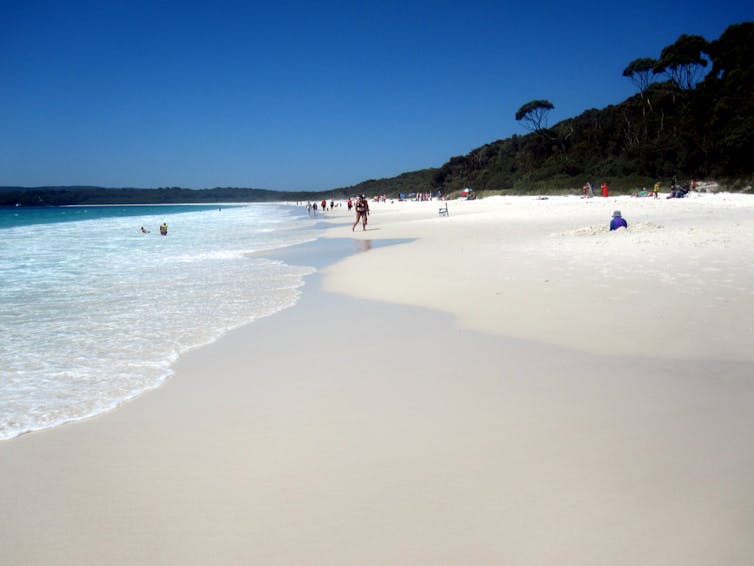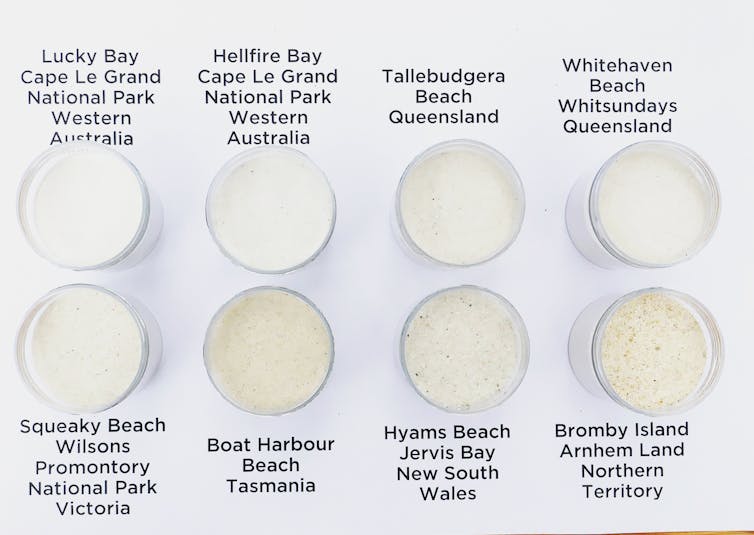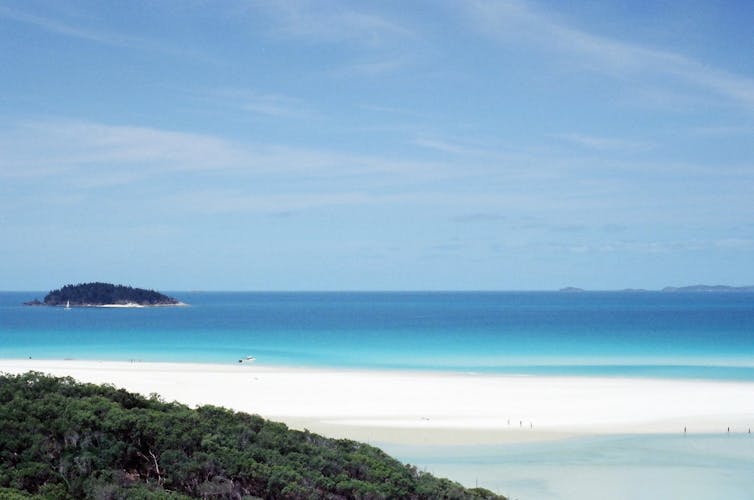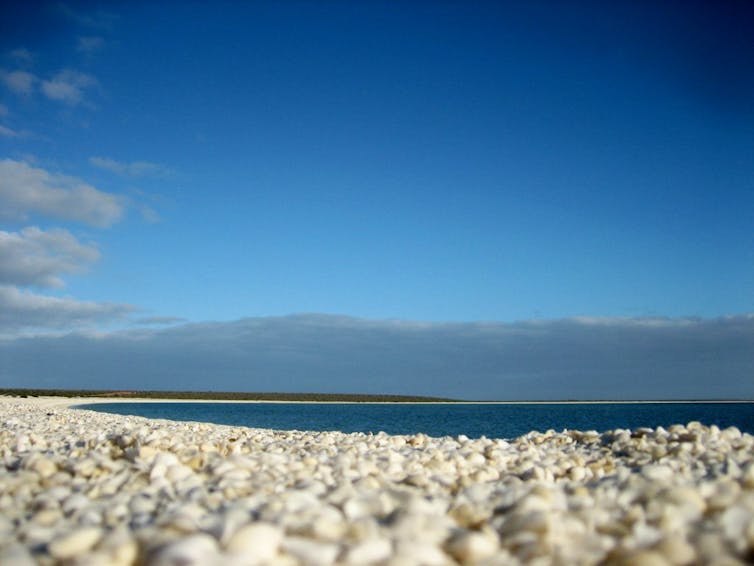Lucky winner: why this beach in WA claims the crown of Australia's whitest sand
- Written by Noel Schoknecht, Senior research associate, Murdoch University
In 2005, when I was chair of the National Committee on Soil and Terrain, I started a debate: where is Australia’s whitest beach? This was a diversion from the committee’s normal business of looking at the sustainable management of Australia’s soils, but it led down a path I hadn’t expected.
What began as a bit of after-hours banter became a serious look across Australia in search of our whitest beaches. New South Wales had already laid claim to the title, arguing that Hyams Beach at Jervis Bay has the whitest sand in the world, purportedly backed up by Guinness World Records.
As it turned out, both claims were false. Guinness World Records has no such category, and the whitest beach (as we found) is actually elsewhere.
 Hyams beach in Jervis Bay, NSW, has been rumoured to have the whitest sand in Australia.
Kristina Kl./Flickr, Author provided
Hyams beach in Jervis Bay, NSW, has been rumoured to have the whitest sand in Australia.
Kristina Kl./Flickr, Author provided
So we drafted terms of reference, and the search for Australia’s Whitest Beach began. Over the next year samples were collected across the nation. The criteria were simple: samples had to be taken from the swash zone (the gently sloping area between the water and the dunes) and the samples could not be treated in any way apart from air-drying. No bleaching. No sieving out of impurities. Marine environment only.
The results of the first judging in 2006 were startling. Of all the states and territories, the much promoted Hyams Beach in New South Wales came in fourth. Third was Victoria, second Queensland, and first Western Australia.
The other states and territories came in at Tasmania fifth, Northern Territory sixth, and South Australia seventh. The ACT didn’t have a beach to sample, although technically some of the Commonwealth lands around our coasts could possibly come in under their banner (but that’s another debate altogether).
 A sample of the main contenders for the whitest beach in Australia. Unfortunately, samples submitted from South Australia didn’t make the final cut.
Photo: Noel Schoknecht, Author provided
A sample of the main contenders for the whitest beach in Australia. Unfortunately, samples submitted from South Australia didn’t make the final cut.
Photo: Noel Schoknecht, Author provided
The winning beach was Lucky Bay in Cape Le Grand National Park on WA’s south coast, but in reality any of the beaches in this area could have been winners – Hellfire Bay, Thistle Cove and Wharton’s beach (just to name a few) are all magnificently white.
A quick qualification here: the southwestern end of Lucky Bay, where many people enter the beach, is covered with seaweed – not the whitest bit! I should also note that all of the finalists in the whitest beach challenge were in their own right fabulously white. But when compared side-by-side, some beaches are clearly whiter than others.
The Queensland team felt aggrieved, so in 2007 I carried out a repechage with new samples from Queensland at Whitehaven Beach in the Whitsundays, and Lake McKenzie on Fraser Island. Lake McKenzie was ultimately disallowed as it is a freshwater lake and the rules stipulated a marine environment. Meanwhile, Whitehaven didn’t quite cut the mustard in the judging and Lucky Bay in WA was again the winner.
 Whitehaven beach in Queensland just missed out on the top spot in the recount.
Jared Yeh/Flickr, CC BY-NC-SA
Whitehaven beach in Queensland just missed out on the top spot in the recount.
Jared Yeh/Flickr, CC BY-NC-SA
So what makes a beach white, and is it important anyway?
The assessments were based on a visual comparison, so to remove any possible visual bias after the 2007 challenge all the samples were scanned for their reflectance – how much light bounced off the sand, essentially – in the visible and infrared wavelengths. Our assumption was that higher reflectance throughout the visual spectrum correlates with greater whiteness.
As it turned out, the results from the scanning exactly correlated with the visual assessments. The eye is quite good at discerning small differences in colour and reflectance. (More background and the results from the competition are available here.)
So what makes a beach white? Obviously, a pristine environment helps. Another factor is the distance from rivers, which deliver coloured organic and clay contaminants to the coast.
The geology of the area and the source of the sand are also critical, with quartz seemingly a major requirement for fine sands. Most white sandy beaches are derived from granitic, or less commonly sandstone, geologies that weather to produce fine, frosted quartz sand grains. Interestingly, sands made from shell or coral fragments just aren’t as white.
 The source of the sand is very important; sand made from shells or coral aren’t as white as quartz.
Tracey Croke/Flickr, CC BY
The source of the sand is very important; sand made from shells or coral aren’t as white as quartz.
Tracey Croke/Flickr, CC BY
Is it important?
While this competition began in fun, I do believe it’s important. Beaches are places of refuge in this crazy world, and a pristine white beach indicates a cleanliness that is worth striving for. The reflectance of light off these sands through shallow waters near the beach creates a surreal, magical turquoise colour. White beaches are like the canary in the coalmine – once they’re spoiled, we know we’re in trouble.
Even though this study was a first look at some of Australia’s whitest beaches, and sampling was limited, it did highlight the sheer number of wonderful sandy beaches that Australia has.
The story’s not finished though. There are many white beaches out there yet to be sampled, and if you’d like to alert me to your potentially award-winning beach please email me or leave a comment on the whitest beach website.
It’s our responsibility, and I believe honour, to protect these amazing places. I’m sure there are more wonderful beaches out there that we haven’t sampled which may defeat Lucky Bay.
Shelburne Bay in northern Queensland, for example, is a contender yet to be sampled, and there are some magnificent beaches on the east coast of Tasmania. Whatever the outcome, let’s celebrate the natural wonders that surround our country.
Authors: Noel Schoknecht, Senior research associate, Murdoch University





